 History
History  History
History  Pop Culture
Pop Culture 10 Cases of Grabbing Defeat from the Jaws of Victory
 History
History 10 Common Misconceptions About the Renaissance
 Weird Stuff
Weird Stuff 10 Crazy Things Resulting from Hidden Contract Provisions
 Facts
Facts 10 Unusual Facts About Calories
 Weird Stuff
Weird Stuff 10 Days of Humiliation When the Person Should Have Stayed in Bed
 Humans
Humans 10 Surprising Ways Game Theory Rules Your Daily Life
 Food
Food 10 Popular (and Weird) Ancient Foods
 Animals
Animals Ten Bizarre Creatures from Beneath the Waves
 Technology
Technology 10 Unexpected Things Scientists Made Using DNA
 History
History 10 Events That Unexpectedly Changed American Life
 Pop Culture
Pop Culture 10 Cases of Grabbing Defeat from the Jaws of Victory
 History
History 10 Common Misconceptions About the Renaissance
Who's Behind Listverse?

Jamie Frater
Head Editor
Jamie founded Listverse due to an insatiable desire to share fascinating, obscure, and bizarre facts. He has been a guest speaker on numerous national radio and television stations and is a five time published author.
More About Us Weird Stuff
Weird Stuff 10 Crazy Things Resulting from Hidden Contract Provisions
 Facts
Facts 10 Unusual Facts About Calories
 Weird Stuff
Weird Stuff 10 Days of Humiliation When the Person Should Have Stayed in Bed
 Humans
Humans 10 Surprising Ways Game Theory Rules Your Daily Life
 Food
Food 10 Popular (and Weird) Ancient Foods
 Animals
Animals Ten Bizarre Creatures from Beneath the Waves
 Technology
Technology 10 Unexpected Things Scientists Made Using DNA
10 Of The Most Impressive Ants On The Planet
With the upcoming movie Ant Man receiving so much hype, many people are asking, “What’s so special about ants?” They’re small pests at best and full-blown infestations at worst. They scurry all around us, and we rarely even notice. It’s not until you get down to their level that you begin to see how interesting, utterly fascinating, and terrifying the world of ants truly is.
If you could shrink down to the ants’ size and live in their world, you would witness a savage struggle as old as the dinosaurs. Theirs is a violent world full of ruthless royalty, cutthroat raiders, cunning thieves, globe-spanning armies, and sometimes even comic book superpowers. We’ve talked before about some of the strange things ants do. Here are 10 of the most unbelievable ants on Earth.
10 Cardiocondyla Obscurior
Mafia Ants
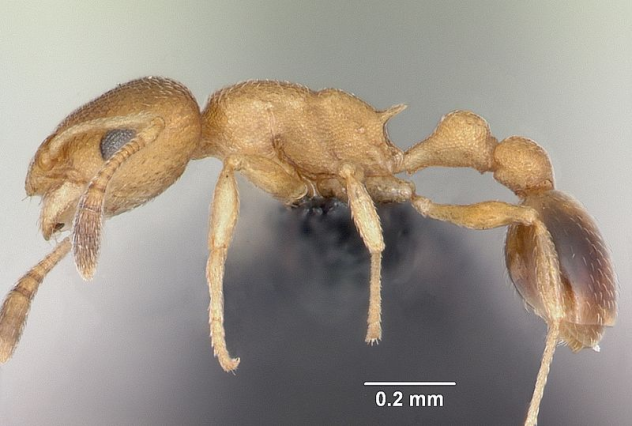
There is only one C. obscurior male per colony. He’s the ergatoid, the dominant male ant, and he must defend his territory. If a new male wonders in for some mating, the reigning ergatoid will dab chemicals from his anus onto the intruder. This butt secretion will cause all of the workers to band together and kill the newcomer. C. obscurior males have a “kill” scent.
That’s not all that they’ll do. In an effort to further reduce any possible rivalry, the ergatoid combs the nurseries looking for newborn males to slaughter. The soft one-day-olds are easy pickings. However, if they find a two-day-old male whose armor has hardened, it becomes a pitched battle with a 14 percent chance that the young ant wins and a 43 percent chance that they will both die. This is mostly because they’re both rubbing their kill scents on each other, encouraging the workers to kill, kill, kill. Many times, the workers end up slaying them both, but it’s okay if they both die. New male are always being born, and the dead ones are fed to the larvae.
9 Crematogaster Striatula
Mass-Murder Ants
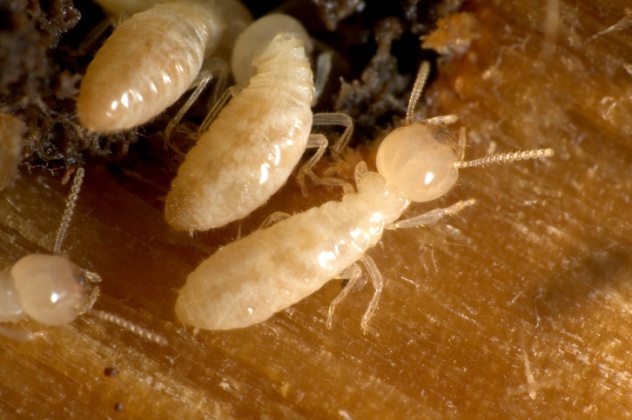
Ants and termites are mortal enemies. Their conflict has gone on for millions of years. In that time, they’ve developed some awesome weapons, but perhaps none so potent as the African ant Crematogaster striatula. C. striatula specializes in hunting termites. They have a potent poison which induces death seizures in termites. However, they don’t inject it as venom; they release it into the air as an aerosol spray to kill termites from a distance. They’ve perfected nerve gas! Under the Geneva Protocol, these ants would be committing war crimes.
When C. striatula encounter a termite, they’ll raise their backside (gaster) in the air and point it at their prey. (Note that Crematogaster ants are flexible enough to point their gaster in almost any direction.) Then they slowly back toward their victims. In a matter of minutes, the termites will be lying on their backs with their legs kicking in the air until they die. (Apparently, the termites aren’t smart enough to consider fleeing the gas.) This aerosol poison also protects C. striatula against other species of ants. Researchers have never recorded any of these ants dying, because they were smart enough to turn around and run.
8 Temnothorax Pilagens
Invisible Ants
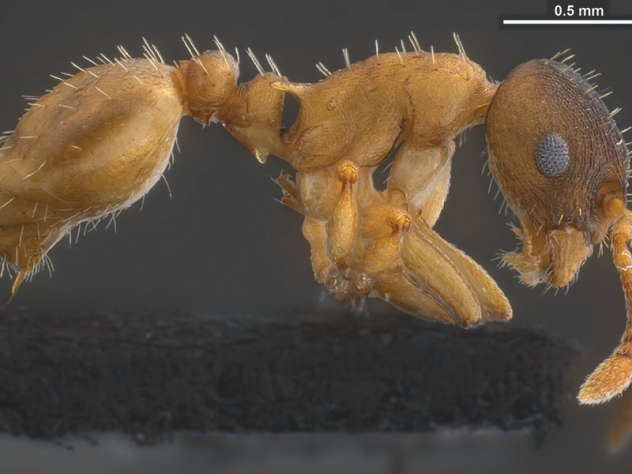
Temnothorax pilagens, or pillage ants, are very small slave-maker ants with a unique set of skills. Slave-maker ants don’t have their own workers, so they steal other ants’ larvae and use them as slave labor.
Pillage ants are very small, and they raid colonies of ants that are themselves so small that they live in a single acorn. These little acorn fortresses only have one entrance. So how do pillage ants gain access? They walk in through the front door. Usually, they aren’t even noticed. Scientists think they have some sort of chemical camouflage that allows them to remain mostly undetectable to their enemies. In other words, they possess chemical invisibility.
But sometimes they are found out, in which case fighting ensues. In such scenarios, the small pillage ant will stab its opponent in the neck with paralyzing venom that kills it quickly. Pillage ant casualties have never been observed from these fights, whereas the other ants can suffer anywhere from 5–100 percent losses. That’s quite an impressive feat, considering that pillage ants never attack in groups larger than four individuals.
7 Solenopsis Fugax
Baby-Eating Tear Gas Ants
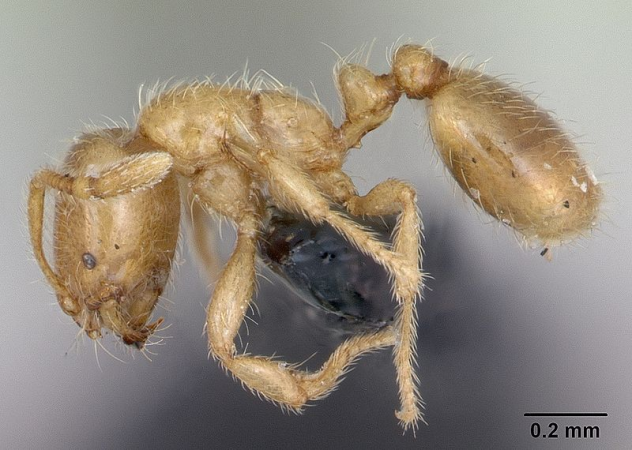
Solenopsis fugax is a thief ant, meaning that it steals from other ant colonies. However, S. fugax steals the larvae of other ants. Slave-maker ants do the same thing, but S. fugax doesn’t need slaves; they’re hungry. They eat the babies of other ants. They also tend to aphids, so they’re farmers who also eat babies on the side.
While most slave ants charge in recklessly and try and overwhelm a colony, S. fugax ants tunnel in. Once they find the brood chamber, they discharge pheromones that repel the other ants. It’s the ant equivalent of tear gas. They tunnel in, spray the place down to make all the adult ants run, and then they abscond with the brood, which will be eaten alive. The poison from a single S. fugax ant is enough to keep workers from 18 different species away for up to an hour.
6 Cephalotes Specularis
Master Infiltrators
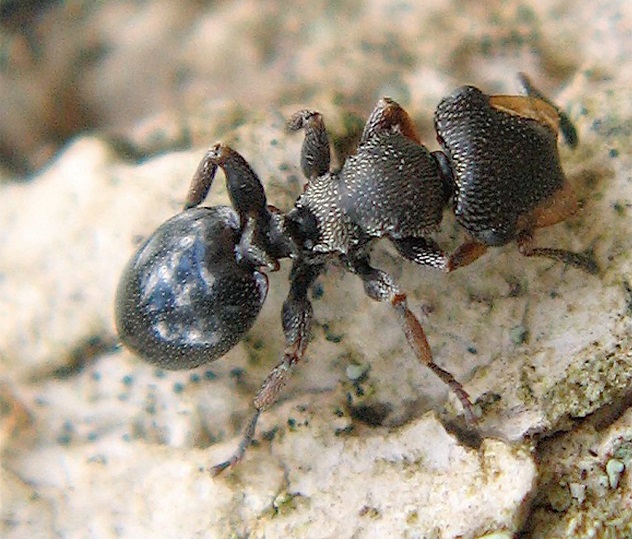
Imagine that this is World War II, you’re behind enemy lines, and you’re hungry. You’ve got fair skin, blond hair, and blue eyes, so you put on a Nazi uniform, straighten your back, and walk right into the mess hall. The only problem is you don’t speak any German. Sounds pretty difficult to pull off, right? Now, imagine doing this every day for the rest of your life. This is how mirror turtle ants live.
They follow hostile Crematogaster ampla ants to food sites and then start trying to act like them. Mirror turtle ants don’t smell anything like C. ampla, so if they come within sniffing range, they’ll be swarmed and dismembered. They have to move like the enemy and walk like the enemy, all while not getting too close to them, even though they’re in the midst of the enemy and stealing their food. Mirror turtle ants are the first species of ant documented to use visual mimicry to parasitize another ant species. The workers foraging behind enemy lines raise their rear ends up in the air and mimic the walking speed and even the stilt-like posture of C. ampla. And they do it all so they don’t have to search for food themselves.
5 Formicoxenus Nitidulus
The Untouchable Ant

Parasitic ants have developed ways to live within host ant colonies. They don’t forage for themselves, they don’t work, and they don’t protect the hive; they just mooch. Most parasitic ants have one specific type of host ant they can parasitize. They’ve learned the smells and behaviors of that one species and how to exploit them. Formicoxenus nitidulus, also known as the shining guest ant, however, can parasitize the nests of 11 different species.
A single shining guest ant colony can even live sprawled among multiple host nests at the same time. The ants can pull this amazing bit of mooching because they apparently taste awful. Any time a guard picks one up, they immediately drop it. When your hands and your mouth are the same thing, enemies that taste gross are probably very difficult to deal with. No other ant is known to employ this “taste really bad” strategy. How well does it work? Some host mounds can be parasitized by over 100 F. nitidulus colonies. That’s quite an infestation problem.
4 Dinoponera Quadriceps
Medieval Justice Ants
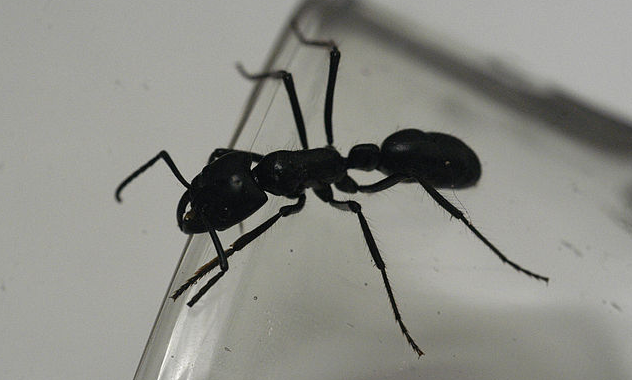
Dinoponera quadriceps (dinosaur ants) are a little primitive, as their name suggests. They’re bigger than normal ants, over 2.5 centimeters (1 in) long, and everyone in the colony has the ability to reproduce. Instead of a queen, they have an alpha female. She’s surrounded by up to five beta females, who do nothing but sit around all day long. These betas are next in line if something should happen to the alpha.
Sometimes a beta gets tired of waiting and decides to start laying eggs of her own. If the alpha female detects that her position is being challenged, she wipes chemicals from her stinger onto the would-be usurper. At that point, the workers will run out to punish the offending ant. They will pin the overreaching beta to the ground, sometimes for up to four days. After justice has been meted out, the beta also loses her rank and is just a lowly worker from then on, or she’s dead from not eating for four days. Dinosaur ants put traitors to the rack.
3 Pachycondyla Chinensis
Needle Ants

There are only five ants in the top 100 worst invasive species list. Of the five, the Argentine ant has the world’s largest super colonies, the three biggest of which, in California, Europe, and Japan, are actually all part of the same global mega-colony. They are incredibly successful at driving off the competition, and there is no ant out there that can beat them in a straight fight . . . except one.
Recent research indicates that another invasive species, the Asian needle ant (Pachycondyla chinensis), is taking territory away from the Argentine ant. This is a first, because Argentine ants do not lose. They’re very adaptable and fiercely defend their territory. So why are they suddenly being pushed back by the needle ant? Scientists aren’t quite sure. Argentine ants seem to avoid needle ants, and no one knows why.
It’s possible that the needle ants are eating their South American cousins, because that’s what they do. They specialize in eating termites and other ants. Another reason could be that Asian needle ants can tolerate cold weather better than most ants. That means they have a longer season to mate, build nests, and eat their neighbors. While most scientists may be happy that there’s at least one ant out there capable of taking on the dreaded Argentine Ant, it’s probably not cause to celebrate. Needle ants have a painful sting that can cause allergic reactions. More people are allergic to Asian ant stings than to honeybee stings, while the bite of the Argentine ant is fairly typical and not particularly painful.
2 Pheidole
Prehistoric Super Soldier Ants
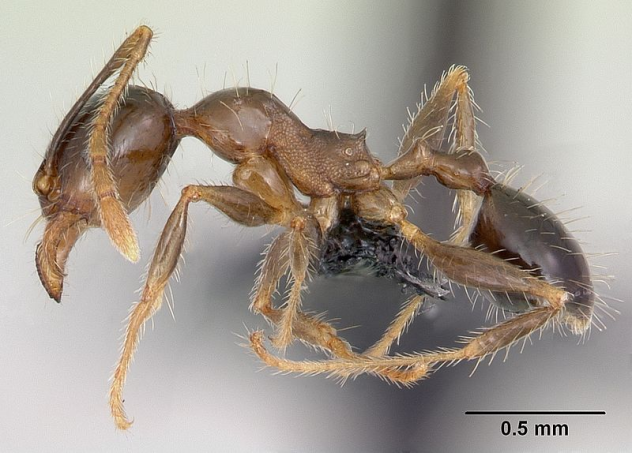
Pheidole is a genus of ant where the soldiers have really, really big heads. Unsurprisingly, they’re called big-headed ants. One species, Pheidole megacephala, is also in the top 100 worst invasive species list. They use their large noggins to grind seeds, block holes to defend the hive, and to cut up their competition. Recent research on P. megacephala shows that the size of their head actually corresponds to the severity of the local competition. In a difficult environment like Australia, they will grow their heads three times bigger than in an easy, laid-back place like Hawaii.
Perhaps the most unique thing about the Pheidole genus as a whole is the supermajor caste. Big-headed ants have three castes: minors, majors, and supermajors. The minors are workers, the majors are the soldiers with big heads, and the supermajors have even more massive heads. These supermajors can have melons that are as much as three times the size of the regular soldiers’ heads. Of the 1,100 species of Pheidole, only eight are known to have supermajors.
Researchers recently found a few of these mega soldiers in a nest of Pheidole morrissi, a species of big-headed ants that doesn’t make supermajors. With a little experimentation, they were able to create supermajors in the lab from regular P. morrissi ants. The scientists now believe that all members of the Pheidole genus have the capacity to create supermajors, and this is a throwback mechanism that dates back to their prehistoric ancestors 35–60 million years ago. Yes, we now know the secret to creating super dinosaur ants.
1 Nylanderia Fulva
Crazy Ants With Crazy Powers
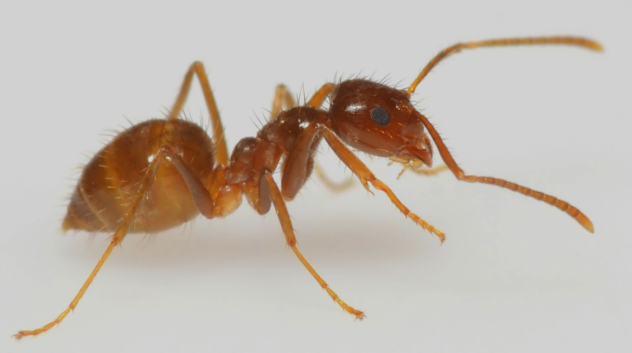
It seems like crazy ants are in the news all the time these days with all kinds of crazy stories, but there are actually three distinct types of crazy ants (their real name). Paratrechina longicornis, the longhorn crazy ant, is the one that overran Bioshpere 2, a contained ecosystem built in Arizona in the 1980s, killing almost all the other insects in the enclosed environment. They can clone themselves, and if they mate with a son, they can clone him, too, so there’s no inbreeding.
Meanwhile, Anoplolepis gracilipes, the yellow crazy ant, is eating all the crabs on Christmas Island and deforming baby sea birds in Hawaii into hideous monsters by spraying them with acid.
By far, the craziest of the crazy ants is Nylanderia fulva, the tawny or raspberry crazy ant. These bad boys are destroying the hated fire ant all over the southern United States. Fire ants have an extremely potent poison. A sort of topical insecticide, it’s up to three times more toxic than DDT. Most other ants can’t deal with that, but tawny crazy ants have a secret defense. When they’re hit with fire ant poison, they quickly coat themselves in their own poison. Somehow, this neutralizes the fire ants’ primary weapon with a 98 percent survival rate. Then, just to make it even more weird, the act of using tawny ant poison to counter fire ant poison somehow creates an ionic liquid which has never been seen before in nature.
Monte Richard II has several animal articles floating around the Internet. He also writes about his latest gaming obsession at tryhardarena.com.








